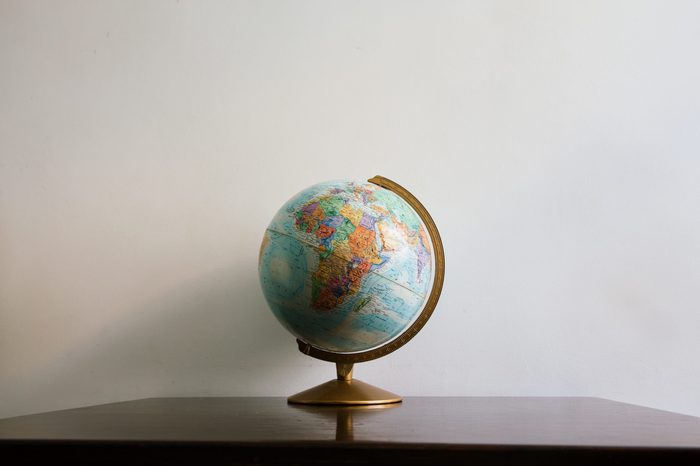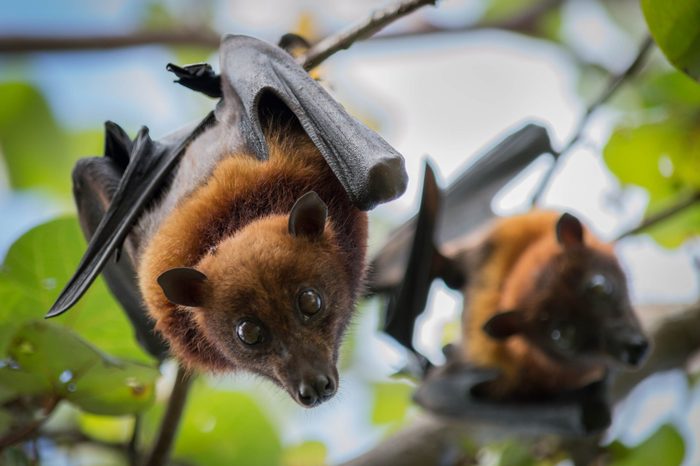
Who knew!
It’s a big world out there, and there’s a lot to know. Of course, most of us don’t have the time to sit around and read all day, absorbing all the information that’s out there. That’s why we’ve created a shortcut for you: a list of 25 of some of the most interesting world facts. Be sure you also don’t miss these amazing “did you know” facts most people actually don’t know.

Why we can’t tickle ourselves
Even if you’re incredibly ticklish, you may have noticed that tickling yourself doesn’t actually work. So why is that? According to research out of University College London, when we try to tickle ourselves, a part of our brain called the cerebellum predicts the sensation. That prediction cancels the response of other brain areas to the tickle.

Earth isn’t perfectly round
Time for some literal world facts: Earth’s radius at the equator is 3,963 miles (6,378 km), according to NASA’s Goddard Space Flight Center. But if you think the Earth is perfectly round, think again. Because of our planet’s rotation, there is a slight bulge at the equator. In fact, Earth’s polar radius is 3,950 miles (6,356 km), which is a difference of 13 miles (22 km). If the planet were a perfect sphere, that difference wouldn’t exist. And while we’re on the subject of space, here are 13 amazing facts about the women of NASA.

Female babies are born with all the eggs they’ll ever have
Babies that are born with a uterus and ovaries actually developed all the eggs they’re ever going to have while they were forming in utero, according to the Cleveland Clinic. They start losing eggs before they’re even born: fetuses have between 6 and 7 million eggs; after birth, babies are left with around 1 million. Once puberty starts, the girl will have around 300,000 eggs. Here are 9 other bizarre facts about newborn babies that doctors don’t tell you.

The flush toilet was invented in 1596
Though we think of flush toilets as a pretty modern convenience, the first version of it was actually invented back in 1596 by Queen Elizabeth I’s godson. It required seven-and-a-half gallons of water to flush—which is a lot when you consider today’s toilets require an average of 1.6 gallons—but on the other hand, up to 20 people could use it between flushes. But this version of the flush toilet didn’t really catch on. According to Smithsonian Magazine, they didn’t take off until 1851. For more world facts about toilets, find out the real reason why toilet paper is white.

Narnia is based on a real-life place
Believe it or not, the fictional location of Narnia, from C.S. Lewis’s Chronicles of Narnia book series, is based on a real place. According to the World Atlas (which, not surprisingly, is full of world facts), Narnia was a town that existed more than 2,000 years ago on the Italian peninsula, approximately 50 miles away from Rome.

Russia is the largest country in the world
Out of all the countries in the world, Russia is the largest in size, coming in at 6.6 million square miles (17.1 million square kilometers), according to the World Atlas. In fact, it’s so massive that even if it lost 2.7 million square miles (7 million square kilometers) of territory, it would still be the biggest country. Some world facts are bigger than others! Interestingly, not a single one of the world’s most populated cities are in Russia.

Somalia is perceived to be the most corrupt country
When it comes to levels of corruption, not all governments are created equal. So an organization called Transparency International publishes a list each year of the countries that are perceived to be the most corrupt in the world. The most recent data is from 2018 when Somalia was rated the country with the most perceived corruption in the world. Don’t miss these 46 weird facts most people don’t know.

The largest stadium in the world is in North Korea
There are some massive sports stadiums, but one is the biggest of them all. It’s called the Rungrado 1st of May Stadium, and it’s located in North Korea. It has a capacity of 114,000 people and hosts football games as well as a festival called Arirang comprised of gymnastics and artistic games. Here are some other random trivia facts you’ll wish you knew sooner.

France is the most-visited country in the world
Turns out, no one can really forget Paris: it is the most-visited city in the world. In fact, France receives around 89 million visitors each year, according to the World Atlas. Nearly 10 percent of the country’s GDP comes from tourism, so it’s big business over there. Having 37 UNESCO World Heritage sites definitely doesn’t hurt. These are the other most popular travel destinations in western Europe.

O-positive is the most common blood type
Do you know your blood type? It’s handy (and important) information to know and will let you know if you fall into a category with plenty of other people, or have a type that is rarer. According to the American Red Cross, there are eight common blood types: A+, A-, B+, B-, O+, O-, AB+, and AB-. The most common of these, O+, can be found in 38.67 percent of the world’s population. Yes, some world facts can save lives. Here’s more about why Type O is the most common blood type.

Vatican City is the smallest country in the world
Strangely, the smallest country in the world is located within a major city. That city is Rome, and the country is Vatican City, also known as the Holy See. Coming in at 0.17 square miles (0.44 square kilometers) it’s tiny but massively wealthy. In fact, the Vatican is home to countless priceless works of art, like the Pieta and the Creation of Adam, not to mention St. Peter’s Basilica.

A species of hummingbird lays the smallest bird egg
Hummingbirds are the lightest birds in the world, weighing in at around 0.07 ounces, so it makes sense that they lay the smallest eggs. But the title of the absolute smallest egg in the world fluctuates between two different types of hummingbirds: the bee hummingbird and the Vervain hummingbird. The smallest egg on record, according to the Guinness Book of World Records was 0.39 inches long (10 mm) and weighed only 0.01 ounces (0.365 grams) and came from a Vervain hummingbird.

Cricket is the second most popular sport in the world
You probably already guessed that soccer—known outside of the United States as football—is the most popular sport in the world. But you may not know that cricket is in the number-two spot. The sport has a 2.5 billion person estimated global following and is biggest in the United Kingdom and Commonwealth countries.

Bats argue a lot
It’s no secret that animals communicate with each other all the time. But when scientists recorded and translated the communication between Egyptian fruit bats, it turns out that they weren’t just having a conversation: they were full-on arguing with each other. Sometimes the bats argued about food, while other times their disagreements centered on sleeping arrangements. These are 27 “facts” about animals you have all wrong.

Barns are painted red because of dying stars
You’ve probably noticed that when it comes to barns, the most popular color is red. Yes, that’s because red paint is cheap, but there’s another far more surprising reason. According to Smithsonian Magazine, red paint is so inexpensive because red ochre (Fe2O3)—which gives it its color—is a byproduct of nuclear fusion in dying stars. Here are some more astronomy facts you might not have learned in school.

25 million Hula-Hoops were sold in their first four months of production
Hula-Hoops were first marketed in 1957 by Arthur “Spud” Melin, the co-founder of a company called Wham-O, and were an instant success. In fact, 25 million Hula-Hoops were sold during their first four months of production. And though they’re considered a fad, you can still find the classic toy in basements and garages everywhere. Find out the most popular toy the year you were born.

Hair and fingernails actually do not continue to grow after death
There is a commonly held myth that a human body’s hair and fingernails continue to grow after death. While it’s understandable why people think this—the hair and fingernails of corpses do appear longer after a person has been dead a while—they’re actually not growing. Instead, the skin around the scalp and fingers begins to recede, giving the illusion of growth, according to the University of Arkansas for Medical Sciences. Here are more weird facts most people don’t know.

Your long-lost baggage may be in Alabama
Having an airline lose your luggage is one of the most annoying parts of travel. But most of the time, we get the lost baggage back, safe and sound. But in other situations—when the bags are unmarked and remain unclaimed—they are sent to Scottsboro, Alabama, where they are sold at the Unclaimed Baggage Center. According to Quartz, the 40,000 square foot retail space stocks around 6,000 items daily, with around 85 percent coming from lost luggage. It’s not just luggage that gets lost—find out 18 of the craziest things left behind at airports.

Listerine invented the concept of halitosis
Bad breath has always existed—especially before brushing your teeth became the norm. But the concept of “halitosis,” the alleged medical condition of having foul breath—was utilized by the Listerine company in the 1920s to sell the product as mouthwash. Previous to that, Listerine was marketed as a general household cleaner, good for everything from washing the floors to cleaning your feet, to treating gonorrhea, according to Smithsonian Magazine.

You probably wouldn’t have heard of the Wright Brothers without their sister Katharine
The Wright Brothers weren’t the only aviation pioneers—we just know about them today thanks to their in-family publicist: their sister Katharine. She graduated from Oberlin University in Ohio in 1898, then began working as a teacher the following year, at the same time her brothers started their experiments with aviation. Then, in addition to running the Wright household, she acted as her shy brothers’ manager—making sure they not only made the news but that the facts about them were accurate. Read more about 18 of the most famous women in flight.

The prototype for a modern bathtub was made from an animal trough
Though people have been bathing for centuries, the modern bathtub as we know it started off as an animal trough. In 1873, John Michael Kohler took a cast-iron water trough, added four feet and covered it in enamel, creating the type of bathtub we’re used to seeing in homes. According to Kohler company lore, the first bathtub was sold to a local farmer for one cow and 14 chickens.

Buenos Aires has the highest percentage of people in therapy per capita
Though New York City has a reputation of everyone having a shrink, Argentina actually has the highest percentage of people in therapy per capita. There are around 198 psychologists per 100,000 inhabitants, with an estimated 46 percent located in the capital of Buenos Aires. Though many types of therapy are available in the country, the most common and popular is psychoanalysis.

You need to burn 7,000 calories to lose one pound of fat
If you’ve ever read a food label and wondered what would take to burn off the calories from a bag of chips or package of cookies, we have an answer. In order to lose one pound of fat, you’d need to burn 7,000 calories. Of course, every body is different, but the long-held belief that 3,500 calories equal one pound of fat is inaccurate.

Guam eats the most Spam in the world, per capita
If you grew up eating Spam—or still enjoy the canned meat today—you may wonder where it’s most popular. Though Hawaii consumes the most Spam in the United States, the Pacific island of Guam eats the most of the stuff per capita in the world. The former U.S. military outpost saw most American servicepeople leave after World War II, but the beloved SPAM imported for the soldiers remained popular with locals. Today, people in Guam eat more than 16 cans of Spam per person, per year—more than anywhere else. Want to learn more about this shelf-stable meat product? Here’s more information on what Spam is, anyway.

The concept of the teenager is pretty new
For most of history, people fit into two categories: children or adults. Of course, some things, like child labor, blurred those lines, but overall, children were children until they got married in their late teens. That is, until the 1920s, when the concept of the “teenager” was born. One reason for this is that the invention of the automobile allowed for teens to gain more independence at an earlier age, prior to marriage. Next, read on to learn 100 fun and interesting facts about basically everything.
